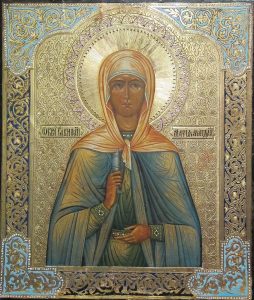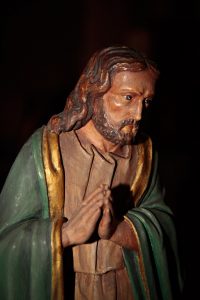As we saw earlier, feminist scholarship has brought to light the leadership role that the woman known as Mary Magdalene from the New (Christian) Testament had in the early days of the Jesus movement. As we noted, she appears numerous times in the Christian Testament and in all four gospels:  Matthew 27.55-56, 61; 28.1; Mark 15.40-41, 47; 16:1, 9; Luke 8.2; 24.10; and John 19.25; 20.1, 11, 16, 18. Mary was a follower and close companion of Jesus of Nazareth, she was identified with the woman out of whom Jesus cast seven devils, she stood by Jesus as he died on the cross and, with two other women, discovered the empty tomb. Mary the Magdalene appears and is named in all Biblical narratives about Jesus’ resurrection, which shows that the early Christian tradition recognized her as a very important figure.
Matthew 27.55-56, 61; 28.1; Mark 15.40-41, 47; 16:1, 9; Luke 8.2; 24.10; and John 19.25; 20.1, 11, 16, 18. Mary was a follower and close companion of Jesus of Nazareth, she was identified with the woman out of whom Jesus cast seven devils, she stood by Jesus as he died on the cross and, with two other women, discovered the empty tomb. Mary the Magdalene appears and is named in all Biblical narratives about Jesus’ resurrection, which shows that the early Christian tradition recognized her as a very important figure.
Groundbreaking scholarship over the past several decades has portrayed Mary called Magdalene as “a leading woman in early Christianity, a spokesperson for the disciples, a visionary who is Jesus’ confidante, a leader who holds her own in debate and whom Jesus loves more than anyone else” (Goodacre, 8). These conclusions come not only from studying the Biblical texts but also literature outside the canon that mention this Mary – positively in The Gospel of Mary, The Gospel of Philip, Dialogue of the Savior, and Pistis Sophia, all dated to the second and early third centuries CE, and more negatively in The Gospel of Peter (late first century CE) and the Epistula Apostolorum (early second century CE).
 Recent research compiled by scholars Mary Ann Beavis and Ally Kateusz is casting new and intriguing light on this figure named Mary and other women connected with Jesus. Articles in the 2020 volume, Rediscovering the Marys: Maria, Mariamne, Miriam, argue that there is a fascinating possibility not only that there is really no one named Mary Magdalene but that she may actually be Mary of Bethany, the sister of Martha and Lazarus.
Recent research compiled by scholars Mary Ann Beavis and Ally Kateusz is casting new and intriguing light on this figure named Mary and other women connected with Jesus. Articles in the 2020 volume, Rediscovering the Marys: Maria, Mariamne, Miriam, argue that there is a fascinating possibility not only that there is really no one named Mary Magdalene but that she may actually be Mary of Bethany, the sister of Martha and Lazarus.
These new observations are important for several reasons. First, if this woman we call Mary Magdalene really did not exist, at least under this name, who is this woman who keeps showing up in stories about Jesus for several centuries, in Biblical and extra-canonical literature? Second, if “Mary Magdalene” is actually the same as Mary of Bethany, does that provide additional evidence for female leadership in the early Jesus movement? Has modern scholarship created the unintentional consequence of “marginalizing other women in the gospel story” by ignoring this possible equation (Goodacre, 22)? Third, if “Mary Magdalene” as the “apostle to the apostles” is only one among many other female leaders in the early Jesus movement, the “scandal of the male-only leadership” that has traditionally held sway for millennia is clearly put to the lie (Goodacre, 24).
Scholars in the Rediscovering the Marys volume point out that the descriptor “Magdalene” as derived from her supposed origins in a city called Magdala does not hold water. As Beavis explains, “No place named Magdala is mentioned in the earliest manuscripts of the New Testament or in other contemporaneous writings:” the site now referred to as Magdala in modern Israel was not called that until the fifth or sixth century CE. In addition, there is no reference to “Mary of Magdala” in the gospels; rather, she is called “the Magdalene” (Beavis, Holy Grail, 230). Perhaps “Magdalene” came from an ancient understanding that migdal means “tower” in Hebrew. However, that would be an odd place name without a further clarifier, such as “tower of London.” Early Syriac translations of the gospels always refer to this Mary as “the Tower-ess,” so “Magdalene” was perhaps a nickname, along the lines of St. Peter as “the rock” (from Kepha/Cephas) (Kateusz, “Two Women Leaders,” 94, and Beavis, Holy Grail, 230).
Given these scholarly challenges to traditional meanings of Mary’s name, the next step is to see how misreadings and even the hunger for power may have steered us wrong and muddied the waters. There is valid reason to believe that Mary called Magdalene and Mary of Bethany are one and the same.  The complicated textual and literary history involves not only Mary and Martha of Bethany and Mary called Magdalene but also Mary the mother of Jesus; it also involves not only these Marys as found in the canonical gospels but also as they appear in later Christian literature. Some of the points raised include the following:
The complicated textual and literary history involves not only Mary and Martha of Bethany and Mary called Magdalene but also Mary the mother of Jesus; it also involves not only these Marys as found in the canonical gospels but also as they appear in later Christian literature. Some of the points raised include the following:
- The main attestation of Mary called Magdalene as “apostle to the apostles” is quite late: in writings of the theologian Hippolytus in the third century CE. It is highly likely that he was referring in his Commentary on the Song of Songs to Mary of Bethany (and her sister Martha) (Beavis, “Which Mary,” 27).
- The tradition of Martha and Mary of Bethany being at Jesus’ empty tomb is very widespread (Beavis, “Which Mary,” 27), so the early equation of this Mary with Mary Magdalene – as portrayed in John (19:25, 20:1, 11, 18) – is understandable. However, in these passages, there is a difference between what each Mary does at the tomb: weeping versus anointing. And there are distinctions between the spellings of Mary’s name/s in the original Greek, which could also have contributed to early confusion and conflation (Beavis, “Which Mary,” 29-30).
- The characteristics that have recently been attributed to Mary Magdalene might be better associated with Mary of Bethany and/or her sister Martha: loved by Jesus (Jn 11:5), Jesus conversing with her (Jn 11:28-33, Lk 10:38-42), Mary rebuked by someone and defended by Jesus (Lk 10:40-42, Jn 12:7-8), etc. (Beavis, “Which Mary,” 28).
- The expanded understanding of the Mary situation in the texts also leads to an expanded discussion of the probable leadership role of Mary the mother of Jesus.
 As Kateusz points out (“Two Women Leaders,” 81), the authors of Luke/Acts and the Gospel of John “appear to have remembered Jesus’ mother in a strong role akin to leadership.” Luke associated her with prophecy in the Magnificat (Lk 1:46-55), and John elevated her during Jesus’ ministry (wedding at Cana, Jn 2:1-11; travel to Capernaum, Jn 2:12; and presence at Jesus’ crucifixion, Jn 19:25-27). In several passages, Jesus’ mother is listed first, which often suggests a leadership role (Jn 2:12, Jn 19:25) (Kateusz, “Two Women Leaders,” 82).
As Kateusz points out (“Two Women Leaders,” 81), the authors of Luke/Acts and the Gospel of John “appear to have remembered Jesus’ mother in a strong role akin to leadership.” Luke associated her with prophecy in the Magnificat (Lk 1:46-55), and John elevated her during Jesus’ ministry (wedding at Cana, Jn 2:1-11; travel to Capernaum, Jn 2:12; and presence at Jesus’ crucifixion, Jn 19:25-27). In several passages, Jesus’ mother is listed first, which often suggests a leadership role (Jn 2:12, Jn 19:25) (Kateusz, “Two Women Leaders,” 82). - The respect for the mother of Jesus as a leader and role model grew over time. The Dormition tradition – the bodily assumption of Mary into heaven according to Roman Catholic and Eastern Orthodox belief – emerged as early as the second century CE. A fifth-century version of this story, which highlights Mary’s leadership role in a liturgical setting, “describes women coming to Jerusalem to learn from her, after which she gave these women writings to take to their home cities” (Kateusz, “Two Women Leaders,” 85-86). In some early communities, and in later traditions as well, as might be expected, scribes copying the manuscripts demoted or erased Mary from these respected roles and even at times substituted Peter (Kateusz, “Two Women Leaders,” 89-90).
There are a number of important takeaways from this cutting-edge research. They are interesting in and of themselves from an academic point of view, but they can also inform us moderns as we continue to be influenced by the Bible, the Christian Testament, and Christianity in general on the status of women in the home, the workplace, and society and under the law. Some of this influence, such as Christian Fundamentalism and white supremacy (often closely tied to Christian Fundamentalism), can be extremely oppressive and even violent – to women and all of us. As Beavis and Kateusz conclude (“Afterword,” 236):
From the standpoint of feminist interpretation, it is important to recognize the significance and contributions of these (and other) specific women as disciples, leaders, heroes, and archetypes, and not to bundle them all into one all-encompassing (generic or literary or composite) “Mary,” as if ancient readers themselves believed there were no historical Marys. In fact, they remembered and honored several.
The notion that women in the early Jesus groups were “meek and mild,” completely under the authority of the men in their lives, and forbidden to hold leadership roles in their communities is a gross distortion of the facts – that is, they are lies perpetrated by (mostly male) leaders in church and society for millennia. We need not totally discard the Jesus story or the positive messages of the Jesus movement as irrelevant or even detrimental for our time; rather, they can be embraced as liberating and just.
Resources
Beavis, Mary Ann. “From Holy Grail to The Lost Gospel: Margaret Starbird and the Mary Magdalene Romance,” in Mary Ann Beavis and Ally Kateusz, eds., Rediscovering the Marys: Maria, Mariamne, Miriam, 227-34. London and New York: T&T Clark, 2020.
Beavis, Mary Ann. “Which Mary, and Why It Matters,” in Mary Ann Beavis and Ally Kateusz, eds., Rediscovering the Marys: Maria, Mariamne, Miriam, 25-38. London and New York: T&T Clark, 2020.
Beavis, Mary Ann and Ally Kateusz. “Afterword,” in Mary Ann Beavis and Ally Kateusz, eds., Rediscovering the Marys: Maria, Mariamne, Miriam, 235-37. London and New York: T&T Clark, 2020.
Beavis, Mary Ann and Ally Kateusz. “Introduction,” in Mary Ann Beavis and Ally Kateusz, eds., Rediscovering the Marys: Maria, Mariamne, Miriam, 1-4. London and New York: T&T Clark, 2020.
Beavis, Mary Ann and Ally Kateusz, eds. Rediscovering the Marys: Maria, Mariamne, Miriam. London and New York: T&T Clark, 2020.
Goodacre, Mark. “The Magdalene Effect: Reading and Misreading the Composite Mary in Early Christian Works,” in Mary Ann Beavis and Ally Kateusz, eds., Rediscovering the Marys: Maria, Mariamne, Miriam, 7-24. London and New York: T&T Clark, 2020.
Kateusz, Ally. “Two Women Leaders: ‘Mary and the Other Mary Magdalene,’” in Mary Ann Beavis and Ally Kateusz, eds., Rediscovering the Marys: Maria, Mariamne, Miriam, 79-96. London and New York: T&T Clark, 2020.
